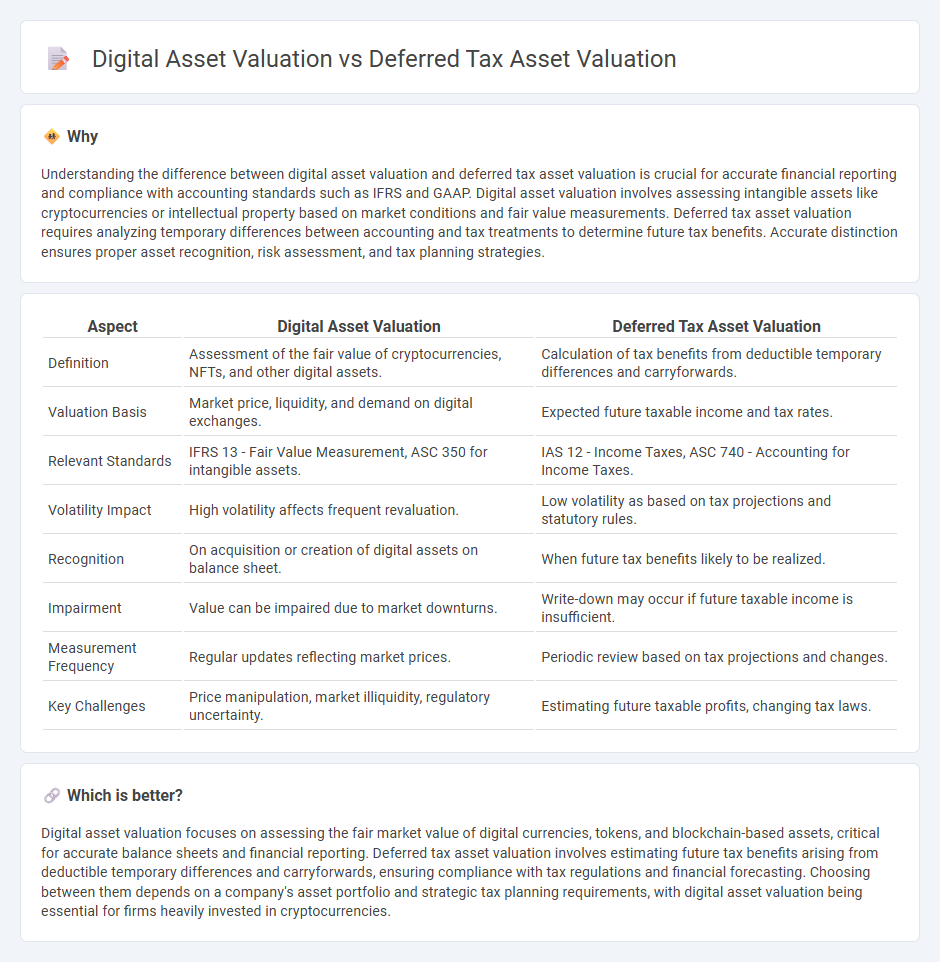
Digital asset valuation involves determining the fair market value of intangible assets such as cryptocurrencies, patents, or digital licenses, which fluctuate based on market demand and technological changes. Deferred tax asset valuation focuses on estimating future tax benefits arising from deductible temporary differences and carryforward losses, which depend on corporate tax rates and future profitability projections. Explore the nuances and methodologies behind both to enhance your understanding of asset management in accounting.
Why it is important
Understanding the difference between digital asset valuation and deferred tax asset valuation is crucial for accurate financial reporting and compliance with accounting standards such as IFRS and GAAP. Digital asset valuation involves assessing intangible assets like cryptocurrencies or intellectual property based on market conditions and fair value measurements. Deferred tax asset valuation requires analyzing temporary differences between accounting and tax treatments to determine future tax benefits. Accurate distinction ensures proper asset recognition, risk assessment, and tax planning strategies.
Comparison Table
| Aspect | Digital Asset Valuation | Deferred Tax Asset Valuation |
|---|---|---|
| Definition | Assessment of the fair value of cryptocurrencies, NFTs, and other digital assets. | Calculation of tax benefits from deductible temporary differences and carryforwards. |
| Valuation Basis | Market price, liquidity, and demand on digital exchanges. | Expected future taxable income and tax rates. |
| Relevant Standards | IFRS 13 - Fair Value Measurement, ASC 350 for intangible assets. | IAS 12 - Income Taxes, ASC 740 - Accounting for Income Taxes. |
| Volatility Impact | High volatility affects frequent revaluation. | Low volatility as based on tax projections and statutory rules. |
| Recognition | On acquisition or creation of digital assets on balance sheet. | When future tax benefits likely to be realized. |
| Impairment | Value can be impaired due to market downturns. | Write-down may occur if future taxable income is insufficient. |
| Measurement Frequency | Regular updates reflecting market prices. | Periodic review based on tax projections and changes. |
| Key Challenges | Price manipulation, market illiquidity, regulatory uncertainty. | Estimating future taxable profits, changing tax laws. |
Which is better?
Digital asset valuation focuses on assessing the fair market value of digital currencies, tokens, and blockchain-based assets, critical for accurate balance sheets and financial reporting. Deferred tax asset valuation involves estimating future tax benefits arising from deductible temporary differences and carryforwards, ensuring compliance with tax regulations and financial forecasting. Choosing between them depends on a company's asset portfolio and strategic tax planning requirements, with digital asset valuation being essential for firms heavily invested in cryptocurrencies.
Connection
Digital asset valuation directly impacts deferred tax asset valuation by determining the fair market value used in tax reporting and financial statements. Accurate valuation of digital assets ensures proper recognition of temporary differences between accounting and tax bases, affecting deferred tax assets calculations. Consequently, misvaluation of digital assets can lead to incorrect deferred tax asset amounts, influencing a company's tax liability and financial health.
Key Terms
Deferred tax asset valuation:
Deferred tax asset valuation involves assessing the future tax benefits arising from deductible temporary differences, tax loss carryforwards, and tax credit carryforwards, requiring analysis of expected taxable income and applicable tax rates. Accurate valuation impacts financial statements by reducing future tax liabilities and improving a company's net asset position under accounting standards such as IFRS and GAAP. Explore further insights into deferred tax asset valuation methods, challenges, and practical applications in corporate finance.
Temporary differences
Deferred tax asset valuation centers on identifying temporary differences between accounting values and tax bases, which create taxable or deductible amounts in future periods. In contrast, digital asset valuation involves assessing the fair market value of virtual currencies or tokens, where temporary differences may arise from recognition timing or impairment adjustments. Explore further distinctions in valuation methodologies and their impact on financial reporting.
Recoverability
Deferred tax asset valuation centers on assessing recoverability based on future taxable profits and adherence to accounting standards like IAS 12, ensuring recognition only when probable economic benefits exist. Digital asset valuation, in contrast, emphasizes market dynamics, technology trends, and liquidity to determine recoverability amidst volatile conditions and evolving regulatory environments. Explore detailed methodologies and best practices to enhance your understanding of recoverability challenges in both domains.
Source and External Links
Deferred Tax Assets and the Valuation Allowance - Exactera - A valuation allowance reduces deferred tax assets to reflect the realistic future tax benefits a company will realize, applied when it is "more likely than not" some deferred tax assets will not be recovered, such as in cases of sustained losses.
Valuation Allowances for Deferred Tax Assets - Windes - Under ASC 740, a valuation allowance offsets deferred tax assets if it is more likely than not (over 50% likelihood) that some portion of the tax asset will not be realized, impacting the income statement accordingly.
Example: How Is a Valuation Allowance Recorded for Deferred Tax Assets? - Bloomberg Tax - A valuation allowance is recorded when deferred tax assets, such as net operating loss carryforwards, may not be fully realizable, with the allowance representing the amount deemed unlikely to be recovered based on future profitability assessments.
 dowidth.com
dowidth.com